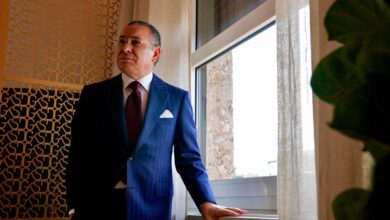“The objective of the new strategy is to enhance the performance of health institutions”

Dr. Bassam Kaddissi’s career began more than 22 years ago in the field of architectural design in many aspects, especially in healthcare design. He gained good expertise in architectural design practice, applicable healthcare guidelines and accreditation standards in Arab hospitals and others … He was appointed as a member of the newly formed Executive Council of the Arab Hospitals Federation to be an advisory member in his field. Dr. Kaddissi, in an interview with the “Hospitals Magazine”, referred to the growth taking place in the Arab Healthcare sector, which is an important investment, especially after the Covid-19 pandemic. The latter was a wake-up call that forced Health sectors and facilities to make rapid changes in their infrastructure and healthcare delivery systems. This led the Arab Hospitals Federation to present a strategy about the new vision in the design of healthcare facilities in the Arab world. Hospitals Magazine recently interviewed Dr. Bassam Kaddissi who shared an overview of the healthcare facility design in the Arab World.
You have been appointed as a member of the Executive Council of the Arab Hospitals Federation, which was recently formed by a group of experts who worked on setting a strategy for the years 2021-2024. In the beginning, can you tell us about this council and its objectives?
The Arab Hospitals Federation appointed a new Executive Council last June which gathers a group of experts from the Arab world. The new Council set a strategic plan for the year 2021-2024 to help the Arab Healthcare sector in general and Arab health institutions in particular, in addition to healthcare workers in advancing health in the Arab countries.
The objective of this strategy is to enhance the performance of health institutions by providing updated health policies, capacity building through a wide range of programs, strategies and plans that include many headlines to be spread in the Arab healthcare sector and among stakeholders, leading to better healthcare services.
We were very impressed by the strategy you are working on, which is the strategy for the new vision in the design of healthcare facilities in the Arab world. Can you tell us why this concept was chosen?
Health is seen as valuable in its own right, but also as a key factor supporting Arab economic growth, and should be recognized as an important investment for the Arab countries.
The challenges we have faced in the last two years, especially the COVID-19 pandemic crisis taught us the importance of being prepared and having robust systems in place. The speed at which the virus spread across the world has left us no time to plan and implement new strategies.
We learned the importance of being ready and prepared, in addition to the importance of having robust Healthcare FACILITIES in place. Therefore, we found the necessity to spread this concept and adopt it in the Arab world in order to help the health institutions be strong and flexible in the future, act quickly in addition to the importance to expand ahead of any future crisis.
Did you find that Arab Hospitals faced design-building problems during the Covid-19 pandemic? And how hospitals can get ready for any future crises through your vision?
Not all healthcare facilities were ready and equipped for the pandemic from isolation or quarantine throughout observation, treatment and recovery. Preparedness in most of the Arab countries was weak, and this should have been planned ahead of time; not only for pandemics but also for disasters, energy resources provision amongst other issues faced by the sector on daily basis.
This strategy in its concept will provide a new vision that fosters the importance of design flexibility, encourages sustainability and green hospital concept, promotes WELL certification, and ensures the adaptation to climate change as well as the adaptation and integration of smart systems and innovations. All of these points will contribute to obtaining a robust healthcare facility building, a strong system capable to face challenges and will develop the healthcare sector in the Arab world.
Tell us what the strategy of the new vision in the design of healthcare facilities in the Arab world will include, and what are the points you stressed on?
The strategy will call for the cooperation between Arab Hospitals to foster the ability of facilities and pathways to respond quickly to potential changes affecting its value delivery, in a timely and cost-effective manner. It will promote evidence-based design, usage of suitable building materials, in addition to conducting regular meetings/workshops for sharing experiences, lessons learned, without forgetting the collaboration with Authorities, Syndicates and Ministries of Health for its implementation.
In your opinion and through your experience in hospitals building, is unifying the healthcare facilities design vision necessary in the Arab world? And how to reach it?
The unification of the healthcare facilities design vision will not be an easy task. Codes, standards, regulations are already set and adopted in all countries. The goal of our vision is to be complementary to those, but the concept of unifying this vision is essential and constitutes an important part of the complete strategy that will carry many concepts and points to eventually have a safe, sustainable, smart, green and comfortable hospital.
Is there a specific date for launching this strategy? How will it be spread and implemented in the Arab health sector?
We are going to launch the strategy at the 23rd annual forum of the Arab Hospitals Federation Medhealth Cairo 2022 which will be held simultaneously with the Arab Health Ministers Council on 15 – 16 March 2022 in Cairo-Egypt.














